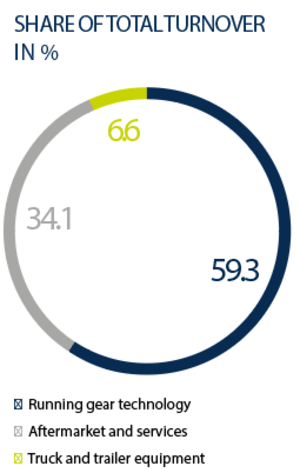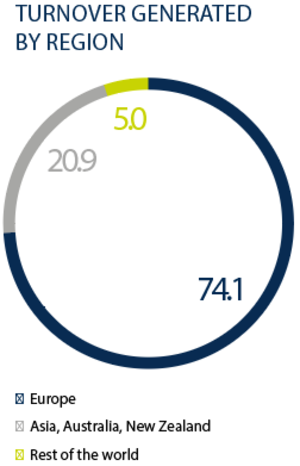Facts &
Figures
EUROS IN TURNOVER
was generated by the consolidated companies of the BPW Group in the 2019 financial year. As such, turnover fell by 7.2% compared to the previous year.
MARKET TRENDS
For 2020, we expect overall economic development to be slightly weaker due to ongoing tensions/decisions in the field of global trade and politics as well as further cost-consolidating industrial measures. For this reason, we expect trailer sales in Europe, including Turkey and the CIS, to continue to slow down slightly, leading to further consolidation in the market. In the Asian market, the introduction of disc brakes in China will open up opportunities for the BPW Group to consolidate and further expand its market position. The BPW Group’s production facilities enable us to supply disc brakes to the market independently of suppliers.
Our planning takes these developments into account, and we are looking ahead to a challenging year 2020 with the aim of achieving a more successful result than the overall market trend. We have taken steps to increase both turnover and market share, combined with rigorous global cost management. We will also enter into further alliances and strategic partnerships for the purpose of driving future-orientated business development.
At the present time, we cannot conclusively assess the impact of the COVID-19 pandemic on the medium-term economic outlook.

| 31.12.2019 | 31.12.2018 | |
| EUR | EUR | |
| A. Noncurrent assets | ||
| I. Intangible assets | ||
| 1. Trademarks and similar rights and assets as well as licenses to such rights and assets | 11,146,686 | 10,317,198 |
| 2. Goodwill | 5,182,364 | 10,603,374 |
| 3. Advance payments | 1.661,226 | 157,693 |
| 17,990,276 | 21,078,265 | |
| II. Property, plant and equipment | ||
| 1. Real estate and buildings | 184,267,505 | 170,474,092 |
| 2. Technical equipment and machinery | 127,690,373 | 136,253,289 |
| 3. Other equipment, furniture and office equipment | 35,511,440 | 37,672,853 |
| 4. Advance payments made and construction in progress | 27,715,927 | 21,170,672 |
| 375,185,245 | 365,570,906 | |
| III. Investments | ||
| 1. Shares in affiliated companies | 2,555,329 | 2,035,951 |
| 2. Loans to affiliated companies | 3,766,521 | 2,849,556 |
| 3. Investments | 1,662,754 | 1,388,083 |
| 4. Loans to companies invested in | 250,000 | 0 |
| 5. Marketable securities | 798,943 | 2,746,063 |
| 6. Other loans | 1,122,721 | 1,381,940 |
| 10,156,268 | 10,401,593 | |
| 403,331,789 | 397,050,764 | |
| B. Current assets | ||
| I. Inventories | ||
| 1. Raw materials, consumables and supplies | 84,088,906 | 88,351,312 |
| 2. Unfinished goods | 69,433,153 | 82,724,007 |
| 3. Finished goods and goods for resale | 183,801,647 | 184,249,265 |
| 337,323,706 | 355,324,584 | |
| II. Accounts receivable and other assets | ||
| 1. Trade receivables | 235,686,292 | 257,973,294 |
| 2. Receivables from affiliated companies | 984,493 | 727,435 |
| 3. Receivables from companies with which an investment relationship exists | 596,698 | 118,347 |
| 4. Other assets | 41,417,694 | 38,279,700 |
| 278,685,177 | 297,098,776 | |
| III. Securities (other) | 4,182,614 | 3,013,194 |
| IV. Cash on hand and bank balances | 139,092,531 | 112,812,381 |
| 759,284,028 | 768,248,935 | |
| C. Accruals and deferrals | 5,758,970 | 4,479,451 |
| D. Deferred tax assets | 14,505,485 | 15,612,875 |
| 1,182,880,272 | 1,185,392,025 | |
| 31.12.2019 | 31.12.2018 | |
| EUR | EUR | |
| A. Equity | 618,495,652 | 594,344,387 |
| B. Accruals | ||
| 1. Accruals for pensions and similar obligations | 49,176,106 | 47,024,850 |
| 2. Tax accruals | 4,974,844 | 2,393,932 |
| 3. Other provisions and accrued liabilities | 64,934,038 | 62,872,257 |
| 119,084,988 | 112,291,039 | |
| C. Liabilities | ||
| 1. Liabilities to financial institutions | 58,588,108 | 72,668,589 |
| 2. Advance payments for orders | 9,943,764 | 11,600,936 |
| 3. Trade payables | 83,902,289 | 100,132,012 |
| 4. Liabilities to affiliated companies | 137,736 | 93,921 |
| 5. Other liabilities (of this t otal, tax liabilities EUR 10,762,109; previous year EUR 8,742,539) | ||
| (of this t otal, as a result of social security EUR 3,628,278; previous year: EUR 3,591,030) | 286,896,082 | 288,926,548 |
| 439,467,979 | 473,422,006 | |
| D. Accruals and deferrals | 5,831,653 | 5,334,593 |
| 1,182,880,272 | 1,185,392,025 |
NOTES TO THE CONSOLIDATED STATEMENT OF FINANCIAL POSITION
as at 31 December 2019
| 1. Turnover | 1,411,937,522 | 1,522,217,228 |
| 2. Wages, salaries, social security contributions and expenses for pensions and other benefits | 311,591,552 | 311,751,752 |
| 3. Valuation and depreciation methods | ||
Purchased intangible fixed assets are carried at cost less scheduled depreciation and amortisation.
Any goodwill resulting from the consolidation of investments is disclosed separately on the consolidated statement of financial position and amortised on a straight-line basis over its expected useful life of between five and a maximum of ten years.
Items of property, plant and equipment are carried at cost and, if subject to wear and tear, amortised on a fixed schedule using the straight-line method over the useful life of the asset. Financial assets are carried at the lesser of cost or fair value. Permanently impaired fixed assets are subject to extraordinary depreciation.
With respect to inventories, raw materials, consumables, supplies, and goods are measured at the lower of cost or market value. Works in progress and finished goods are measured at production cost. In addition to production materials and wages, these include a reasonable share of material and production overheads and the depreciation of fixed assets. Risks resulting from the duration of storage or reduced usability are taken into account through impairments.
Receivables, other assets and cash and cash equivalents were carried at nominal value less impairment losses for individually determined single risks. General provisions are formed to take general credit risks into account.
Other current assets are carried at the lesser of cost or fair value.
Pension provisions formed by domestic consolidated companies are calculated actuarially on the basis of biometric probabilities (Heubeck 2018 G mortality tables) using the entry age normal method.
Future expected pension increases are taken into account when calculating the obligation. In this context, annual adjustments of between 1.0% and 1.75% are currently assumed. Salary increases are not taken into account, as the pension plan provides for an individually fixed monthly pension for each individual entitled person. The actual date the individual joined the company was used as the date upon which funding commenced. Employee turnover is taken into account as part of an actuarial approach in the form of a probability of departure based on age and length of employment and is assumed to be extremely low. The underlying interest rate used to discount pension obligations stood at 2.71% on the measurement date of 31 December 2019 (previous year: 3.21%).
This corresponds to the average market interest rate of the past ten financial years calculated and published by the German Central Bank in accordance with the German Regulation on the Discounting of Provisions (RückAbzinsV) for an assumed remaining term of the obligations of 15 years.
Other provisions take into account all discernible risks and uncertain obligations in the amount of the respective settlement amount. Provisions with a remaining term of more than one year are discounted at the average market interest rate of the past seven years corresponding to their remaining term. In the process, provisions are formed for obligations arising from part-time employment prior to retirement based on the block model. Provisions for part-time employment prior to retirement are measured on the basis of an individual discount rate and the 2018 G mortality tables published by Dr. Klaus Heubeck in accordance with actuarial principles. In this process, annual wage and salary increases of 2.5% were assumed. Provisions for part-time employment prior to retirement include supplementary amounts and the company’s corresponding obligations that had accrued up to the reporting date.
Liabilities are carried at their respective amount payable.
Differences between the carrying amounts of assets and liabilities under commercial law and their valuations for tax purposes, as well as benefits from tax loss carry-forwards that can be utilised with sufficient certainty, are recognised as deferred taxes insofar as the company expects these values to be reduced in later financial years. The tax burdens and tax benefits resulting from the different valuations are offset against each other and recognised either as deferred tax assets or liabilities.
| 2019 | 2018 | |
| 4. Number of employees | 7,002 | 7,362 |
Wiehl, August 2020, the Management Board


AUDITOR’S REPORT
THE FINANCIAL INFORMATION PRESENTED ABOVE IS AN EXTRACT FROM THE CONSOLIDATED FINANCIAL STATEMENTS FOR THE FINANCIAL YEAR FROM 1 JANUARY TO 31 DECEMBER 2019 AUDITED BY OUR COMPANY. ON 5 AUGUST 2020, WE ISSUED THE FOLLOWING AUDITOR’S REPORT ON THE COMPLETE CONSOLIDATED FINANCIAL STATEMENTS AND THE CONSOLIDATED MANAGEMENT REPORT:
INDEPENDENT AUDITOR’S REPORT
BPW Bergische Achsen Kommanditgesellschaft, Wiehl, Germany
AUDIT OPINIONS
We have audited the consolidated annual financial statements of BPW Bergische Achsen Kommanditgesellschaft, Wiehl, and its subsidiaries (hereinafter referred to as the Group) – consisting of the consolidated statement of financial position as at 31 December 2019 and the consolidated statement of income for the financial year from 1 January 2019 to 31 December 2019 – as well as the notes to the consolidated financial statements, including a description of the company’s accounting and valuation methods. In addition, we also audited the group management report of BPW Bergische Achsen Kommanditgesellschaft, Wiehl, for the financial year from 1 January 2019 to 31 December 2019.
IN OUR OPINION, BASED ON THE KNOWLEDGE WE GAINED FROM OUR AUDIT:
- The attached consolidated financial statements comply in all material respects with the provisions of German commercial law applicable under section 13 of Germany’s Public Disclosure Act and, in accordance with the generally accepted accounting principles in Germany, convey a true and fair view of the net assets and financial position of the Group as at 31 December 2019 and of its results of operations for the financial year from 1 January 2019 to 31 December 2019
- The attached group management report provides an accurate impression of the Group’s position overall In all material respects, this group management report is consistent with the consolidated annual financial statements, complies with German legal requirements and suitably presents the opportunities and risks associated with the company’s future performance.
In accordance with section 322(3)(1) of the German Commercial Code, we hereby state that our audit has not led to any reservations regarding the accuracy of the consolidated annual financial statements and the group management report.
BASIS FOR AUDIT OPINIONS
We conducted our audit of the consolidated annual financial statements and the group management report in accordance with section 317 of the German Commercial Code (HGB) while observing the generally accepted German auditing standards promulgated by the German Institute of Auditors (IDW). Our responsibilities under these rules and principles is described in more detail in the section of our audit opinion entitled “Responsibility of the auditor when auditing the consolidated annual financial statements and the group management report”. We are an independent entity in accordance with German commercial and professional regulations and have performed our other professional duties according to German law in accordance with these requirements. We believe that the evidence we have obtained from the audit is sufficient and appropriate to provide a basis for our audit opinions regarding the consolidated annual financial statements and group management report.
RESPONSIBILITY OF THE LEGAL REPRESENTATIVES FOR THE CONSOLIDATED FINANCIAL STATEMENTS AND THE GROUP MANAGEMENT REPORT
The legal representatives are responsible for the preparation and presentation of the consolidated annual financial statements in accordance with section 13 of Germany’s Public Disclosure Act and for ensuring that the consolidated annual financial statements give a true and fair view of the net assets, financial position and results of operations of the Group in accordance with the generally accepted accounting principles in Germany. In addition, the legal representatives are responsible for the internal controls that they have determined to be necessary in accordance with generally accepted accounting principles in Germany in order to ensure that the consolidated annual financial statements are free from any material misstatements, whether intentional or unintentional.
When preparing the consolidated annual financial statements, the legal representatives are responsible for assessing the Group’s ability to continue as a going concern. Furthermore, they have the responsibility to disclose matters that relate to the company’s ability to continue as a going concern, if any such matters exist. In addition, they are responsible for preparing the financial statements in accordance with the going concern principle, except where otherwise required by actual or legal circumstances.
In addition, the legal representatives are responsible for the preparation of the group management report, which must provide an accurate overall view of the Group’s position and be consistent with the consolidated annual financial statements in all material respects, comply with German legal requirements and adequately present the opportunities and risks to the Group’s future performance. Moreover, the legal representatives are responsible for the precautions and measures (i.e. the systems) that they have deemed necessary to ensure that a group management report can be prepared in accordance with the applicable German legal provisions and to provide sufficient suitable evidence for the statements made in the group management report.
RESPONSIBILITY OF THE AUDITOR WHEN AUDITING THE CONSOLIDATED ANNUAL FINANCIAL STATEMENTS AND THE GROUP MANAGEMENT REPORT
Our objective is to be reasonably certain that the consolidated annual financial statements as a whole are free of material misstatements, whether intentional or unintentional, and whether the group management report as a whole provides a true and fair view of the Group’s position and is consistent in all material respects with the consolidated annual financial statements and the findings of our audit, complies with German legal requirements and accurately presents the opportunities and risks to the Group’s future performance, as well as to issue an auditor’s report containing our audit opinions on the consolidated annual financial statements and the group management report.
In this context, reasonable certainty implies a high degree of certainty, but does not guarantee that an audit conducted in accordance with section 317 of the German Commercial Code (HGB), while taking the generally accepted accounting principles as set forth by the German Institute of Auditors (IDW) into account, will always reveal a material misstatement. Misstatements could result from wrongdoing or inaccuracies and are considered material if it could reasonably be expected that they would individually or collectively impact financial decisions made on the basis of these consolidated annual financial statements and group management report.
DURING THE AUDIT, WE EXERCISE OUR BEST JUDGEMENT AND MAINTAIN A CRITICAL ATTITUDE. IN ADDITION, WE:
- Identify and evaluate the risks of material misstatements, whether intentional or unintentional, in the consolidated annual financial statements and group management report, plan and perform audit procedures in response to those risks and obtain audit evidence sufficient and appropriate to provide a basis for our audit opinions. The risk that material misstatements will not be detected is greater in the case of wrongdoing than in the case of inaccuracy, as wrongdoing may involve fraudulent collusion, falsification, intentional incompleteness, misrepresentation or suspension of internal controls
- Gain an understanding of the internal control system relevant to the audit of the consolidated annual financial statements and of the procedures and measures relevant to the audit of the group management report in order to plan audit procedures that are appropriate under the circumstances, but not for the purpose of expressing an opinion on the effectiveness of these systems
- Evaluate whether the accounting policies adopted by management are appropriate and whether the estimates and related disclosures made by management are reasonable
- Draw conclusions about whether the legal representatives’ application of the going concern principle is appropriate and, on the basis of the audit evidence obtained, whether any material uncertainty exists in relation to events or circumstances that could cast significant doubt on the Group’s ability to continue as a going concern. If we conclude that any material uncertainty exists, we are required to express an opinion on the consolidated annual financial statements and on the group management report based thereon or, if the information is inappropriate, to modify our opinion thereon. We draw our conclusions on the basis of the audit evidence obtained up to the date of our audit opinion. Future events or circumstances may, however, result in the Group no longer being able to continue as a going concern
- Express an opinion on the overall presentation, the structure and the content of the consolidated annual financial statements, including the disclosures, as well as on whether the consolidated annual financial statements present the underlying transactions and events in such a way that the consolidated annual financial statements give a true and fair view of the Group’s assets, financial position, and the results of its operations in accordance with the generally accepted accounting principles in Germany
- Obtain sufficient appropriate audit evidence for the accounting information of the companies or business activities within the Group to enable us to express an audit opinion on the consolidated annual accounts and the group management report. We are responsible for instructing, monitoring and conducting the audit of the consolidated annual financial statements. We bear sole responsibility for our audit opinions
- Evaluate the consistency of the group management report with the consolidated annual financial statements, its compliance with applicable law and the overall view of the Group’s position conveyed by it
- Perform audit procedures on the forward-looking statements in the group management report as presented by the legal representatives. In this context, we particularly verify the significant assumptions underlying the forward-looking statements made by the legal representatives and assess whether the forward-looking statements are appropriately derived from these assumptions on the basis of sufficient and suitable audit evidence. We do not express an independent opinion on the forwardlooking statements or the underlying assumptions. There is always a significant and unavoidable risk that future events will differ substantially from the forward-looking statements
Among other measures, we discuss the planned scope and schedule of the audit and significant findings of the audit, including any deficiencies in the internal control system identified during our audit, with those responsible for monitoring the audit.
Cologne, 5 August 2020
SJS Schwieren Jansen Scherer GmbH
Auditors and tax consultants






